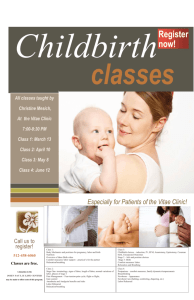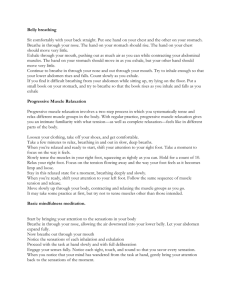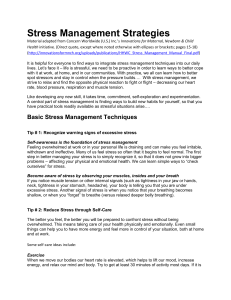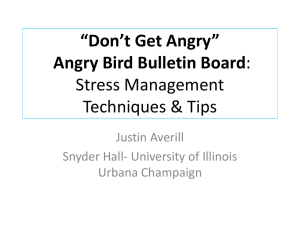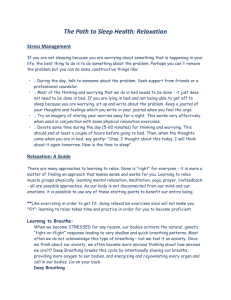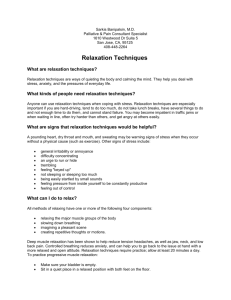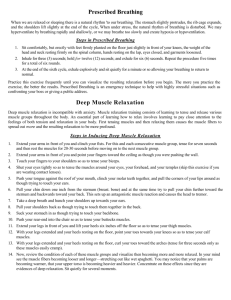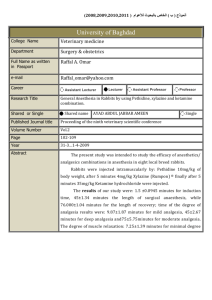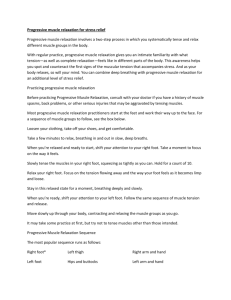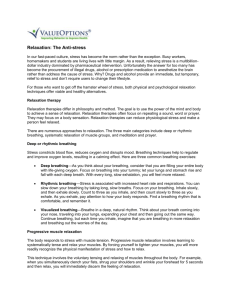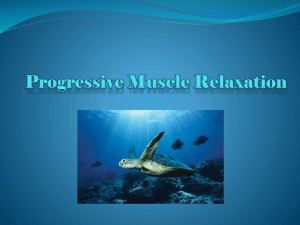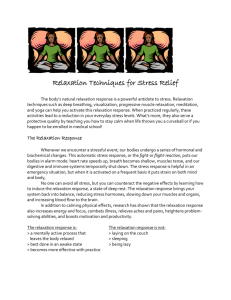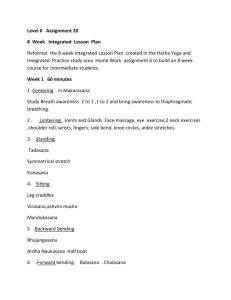*Bad* Breathing - West Lothian Council
advertisement
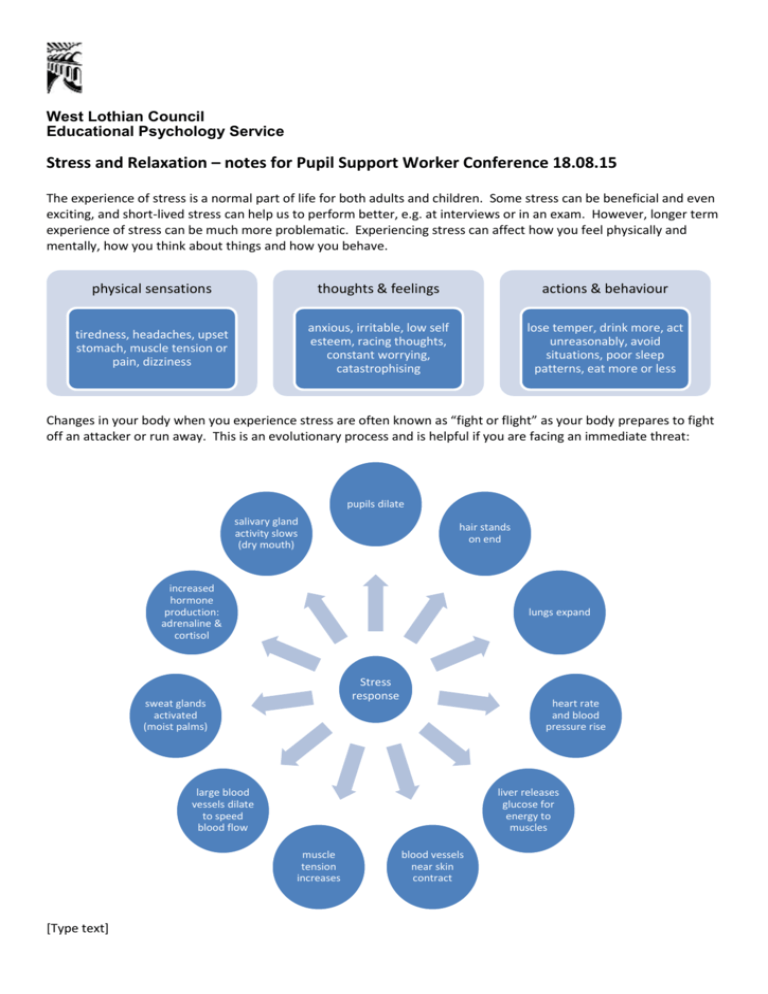
West Lothian Council Educational Psychology Service Stress and Relaxation – notes for Pupil Support Worker Conference 18.08.15 The experience of stress is a normal part of life for both adults and children. Some stress can be beneficial and even exciting, and short-lived stress can help us to perform better, e.g. at interviews or in an exam. However, longer term experience of stress can be much more problematic. Experiencing stress can affect how you feel physically and mentally, how you think about things and how you behave. physical sensations thoughts & feelings actions & behaviour tiredness, headaches, upset stomach, muscle tension or pain, dizziness anxious, irritable, low self esteem, racing thoughts, constant worrying, catastrophising lose temper, drink more, act unreasonably, avoid situations, poor sleep patterns, eat more or less Changes in your body when you experience stress are often known as “fight or flight” as your body prepares to fight off an attacker or run away. This is an evolutionary process and is helpful if you are facing an immediate threat: pupils dilate salivary gland activity slows (dry mouth) hair stands on end increased hormone production: adrenaline & cortisol lungs expand Stress response sweat glands activated (moist palms) heart rate and blood pressure rise large blood vessels dilate to speed blood flow liver releases glucose for energy to muscles muscle tension increases [Type text] blood vessels near skin contract The problem is that when we’re feeling stressed at work/school we’re not usually in a position to do physical exercise and get rid of these hormones effectively. We don’t actually have to fight or run! This isn’t a problem when we only experience stress sometimes, but when we experience significant stress on an ongoing basis this can lead to difficulties with physical or mental health. Think about: What causes stress at work? What causes stress for children at school? External stressors are things which happen to us, and our experience of stress depends on how we respond to external events. Think about: How can external events be controlled to reduce stress? How can we respond differently to events? (“positive reframing”) Can we always choose how we respond to events? Sometimes, stress experienced at work/school will be a result of events which have happened (or are happening) in a different situation, e.g. at home or in relationships. Here are some examples of ways of addressing stress: be active change how you think: be positive, accept what you can't change help others Address Stress! connect with people challenge yourself "me" time: prioritise hobbies & relaxation There are different ways of developing breathing techniques which help with relaxation (e.g. yoga, tai chi). Here’s one guide to a breathing technique for relaxation (adapted from http://thehappyguy.com/stress-breath): [Type text] “Bad” Breathing Shallow “chest breathing” invites problems by delivering less air per breath into the lungs. Too much oxygen and not enough carbon dioxide can create an agitated state. As you learn to exhale slowly, you conserve carbon dioxide and rebalance the system. However, too much carbon dioxide, and not enough oxygen, can create feelings of fatigue and depression. Learning to inhale slowly re-balances your system by taking in more oxygen. Stress, anxiety, and emotions all affect our breathing – the natural “fight or flight” response that increases respiration. “Bad breathing” is also performed through the mouth rather than the nose, especially during exercise or a stressful situation. Breathing through the mouth permits inhaling and exhaling large volumes of air quickly. This can lead to hyperventilation, diminished energy, and a weakening of health and well-being. “Good” Breathing To achieve normal levels of oxygen and CO2 in your system, you begin by focusing your attention on breath! Deep, slow breathing will feel unnatural to many who first try it and may be uncomfortable to some. A slow inhale, followed by holding the breath, and concluding with an exhale twice as long as the inhale will help balance the CO2 level. One technique is called “4-7-8 Breathing” in which you inhale to the count of four, hold the breath to the count of seven, and slowly exhale to the count of eight. Muscle relaxation is a very helpful way to relax. It involves engaging muscle groups then relaxing them, one group at a time. This is often called progressive muscle relaxation. Here is one way of doing it (from http://www.nhs.uk/Conditions/stress-anxiety-depression/pages/ways-relieve-stress.aspx) Deep muscle relaxation This technique takes around 20 minutes. It stretches different muscles in turn and then relaxes them, to release tension from the body and relax your mind. Find a warm, quiet place with no distractions. Get completely comfortable, either sitting or lying down. Close your eyes and begin by focusing on your breathing; breathing slowly and deeply, as described above. If you have pain in certain muscles, or if there are muscles that you find it difficult to focus on, spend more time on relaxing other parts. You may want to play some soothing music to help relaxation. As with all relaxation techniques, deep muscle relaxation will require a bit of practice before you start feeling its benefits. For each exercise, hold the stretch for a few seconds, then relax. Repeat it a couple of times. It’s useful to keep to the same order as you work through the muscle groups: Face: push the eyebrows together, as though frowning, then release. Neck: gently tilt the head forwards, pushing chin down towards chest, then slowly lift again. Shoulders: pull them up towards the ears (shrug), then relax them down towards the feet. Chest: breathe slowly and deeply into the diaphragm (below your bottom rib) so that you're using the whole of the lungs. Then breathe slowly out, allowing the belly to deflate as all the air is exhaled. Arms: stretch the arms away from the body, reach, then relax. Legs: push the toes away from the body, then pull them towards body, then relax. Wrists and hands: stretch the wrist by pulling the hand up towards you, and stretch out the fingers and thumbs, then relax. Spend some time lying quietly after your relaxation with your eyes closed. When you feel ready, stretch and get up slowly. [Type text] This can easily be adapted for children using appropriate visual imagery to make it more interesting for them (email to follow), either as a complete progressive muscle relaxation or as smaller individual exercises. Visualisation techniques can also be used with children. A common visualisation is the “safe place”. Here is one example (from http://www.getselfhelp.co.uk/imagery.htm): Imagine a place where you can feel calm, peaceful and safe. It may be a place you've been to before, somewhere you've dreamt about going to, or maybe somewhere you've seen a picture of. Focus on the colours in your peaceful safe place. Now notice the sounds that are around you, or perhaps the silence. Think about any smells you notice there. Then focus on any skin sensations - the earth beneath you, the temperature, any movement of air, anything else you can touch. Now whilst you're in your peaceful and safe place, you might choose to give it a name, whether one word or a phrase that you can use to bring that image back, anytime you need to. You can choose to linger there a while, just enjoying the peacefulness and serenity. You can leave whenever you want to, just by opening your eyes and being aware of where you are now. Here are some helpful websites: http://www.mind.org.uk/information-support/tips-for-everyday-living/stress/ http://www.stressbusting.co.uk/ http://www.nhs.uk/conditions/stress-anxiety-depression/pages/understanding-stress.aspx Please feel free to contact me for further information: Fiona Sturrock Educational Psychologist Working days: Wednesday, Thursday and Friday fiona.sturrock@westlothian.gov.uk 01506 283114 (direct dial) 01506 283130 (main office) http://www.westlothian.gov.uk/EducationPsychologyService DATA LABEL: PUBLIC [Type text]

